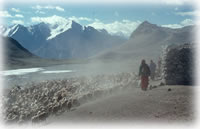 Northern Pakistan borders Afghanistan, China and India and is home to three significant mountain ranges: the Hindu Kush, the Western Himalaya, and the Karakoram. The Karakoram mountain range contains the greatest concentration of high peaks in the world and the longest glaciers outside the Polar region. Five of the world’s 14 peaks over 8000m are in Northern Pakistan, including the world’s second highest mountain K2, and there are some 82 peaks over 7000m within a radius of 180 kilometres. The region is also characterised by much diversity in terms of language and culture. There are more than 10 different languages, several different Islamic sects (including Ismaili, Sunni and Shia), and several communities belonging to non-Islamic belief systems.
Northern Pakistan borders Afghanistan, China and India and is home to three significant mountain ranges: the Hindu Kush, the Western Himalaya, and the Karakoram. The Karakoram mountain range contains the greatest concentration of high peaks in the world and the longest glaciers outside the Polar region. Five of the world’s 14 peaks over 8000m are in Northern Pakistan, including the world’s second highest mountain K2, and there are some 82 peaks over 7000m within a radius of 180 kilometres. The region is also characterised by much diversity in terms of language and culture. There are more than 10 different languages, several different Islamic sects (including Ismaili, Sunni and Shia), and several communities belonging to non-Islamic belief systems.The testimonies in the Pakistan collection are from Shimshal, a community whose territory makes up a significant part of the Karakoram mountain range in Northern Pakistan. It includes many peaks over 6000 metres, numerous glaciers and productive alpine pastures. “We have something…that others don’t: beautiful nature – the mountains and glaciers, and independence,” says Inayat, conveying the pride and attachment Shimshalis have for their environment.
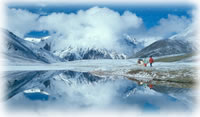 Shimshal village lies at 3100m and most of the cultivatable area lies between 3000 and 3300 metres. The short growing season at this altitude allows only one crop to be cultivated in a year; the major crops are wheat, barley, potatoes and peas. Shimshal is one of the few communities in Pakistan’s Northern Areas that grows enough agricultural produce to feed itself. It is the sole steward of vast areas of high-altitude pasture, and extensive herding of sheep, goats, cattle and yaks allows Shimshalis to earn much of their income from the sale of livestock and livestock products.
Shimshal village lies at 3100m and most of the cultivatable area lies between 3000 and 3300 metres. The short growing season at this altitude allows only one crop to be cultivated in a year; the major crops are wheat, barley, potatoes and peas. Shimshal is one of the few communities in Pakistan’s Northern Areas that grows enough agricultural produce to feed itself. It is the sole steward of vast areas of high-altitude pasture, and extensive herding of sheep, goats, cattle and yaks allows Shimshalis to earn much of their income from the sale of livestock and livestock products.Shimshalis trace their ancestors back 14 generations to their “grandfather” Mamusing who settled in the area with his wife. Their son, Sher, claimed rights over the Pamir – the pastures – after winning a polo match against herders from Kyrgyzstan. Several narrators describe this story in detail. Others recall the era when Shimshal was part of the independent principality of Hunza, ruled and taxed by the Mir. In 1974, President Zulfiqar Ali Bhutto declared an end to the remaining princely states in Pakistan, including Hunza.
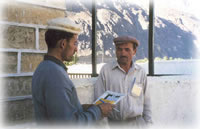 Shimshalis are Wakhi speakers and Ismaili Muslims. Members of the same cultural-linguistic group live in other valleys in Northern Pakistan, as well as the Wakhan corridor of Afghanistan, and parts of China and Tajikistan. Ismailism is a branch of Shia Islam and Ismailis follow their living Imam (spiritual leader), currently the Aga Khan.
Shimshalis are Wakhi speakers and Ismaili Muslims. Members of the same cultural-linguistic group live in other valleys in Northern Pakistan, as well as the Wakhan corridor of Afghanistan, and parts of China and Tajikistan. Ismailism is a branch of Shia Islam and Ismailis follow their living Imam (spiritual leader), currently the Aga Khan.




Shimshal Valley
Shimshal is a farming and herding community of some 1100 inhabitants, situated at the north-eastern extreme of both the former principality of Hunza (now part of Gilgit Administrative District), and the modern state of Pakistan. The settlement occupies the upper portion of a valley of the same name, which descends west into the Hunza River valley at Passu, and which separates the Ghujerab and Hispar Mustagh ranges of the Karakoram mountain system. Shimshal’s villages are situated on a series of glacial and alluvial deposits that form a broad strip between the river's floodplain and steep mountain slopes to the south. These deposits have been terraced for several hundred years. They are irrigated by the meltwater nullahs which currently dissect them. In addition, the lowest terraces are irrigated from the river itself. The cultivated area, covering about 250 hectares, lies between 3000 and 3300 metres above sea level, at the upper limits of single crop cultivation. Shimshalis grow hardy cereals (wheat and barley), potatoes, peas and beans, apricots and apples. Small quantities of garden vegetables are also grown by some households. Shimshalis are one of the few communities remaining in Pakistan's Northern Areas that grows enough agricultural produce to feed itself.
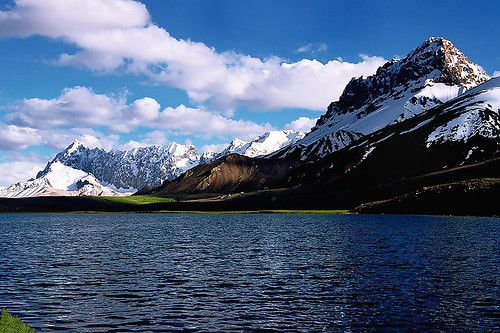
Shimshalis complement their irrigated agriculture with extensive herding of sheep, goats, cattle and yaks. Indeed, they tend more livestock per capita than any other Hunza community, and earn much of their money from the sale of dairy produce, yaks, and yak hair carpets. This is due, in part, to the community's exclusive control of vast areas of high altitude land. Shimshal pastures cover about 2700 square kilometres of the Central Karakoram. Within that area they maintain their three dozen individual pastures, including three large and highly productive alpine areas. Also within Shimshal territory are innumerable peaks, glaciers and trekking routes, including nine peaks above 7,000 metres. Although the environmental potential for adventure tourism is high, relatively few trekkers visit this area. However, with the opening of road from Passu to Shimshal, now the influx of the international as well as the domestic tourists is gradually increasing.
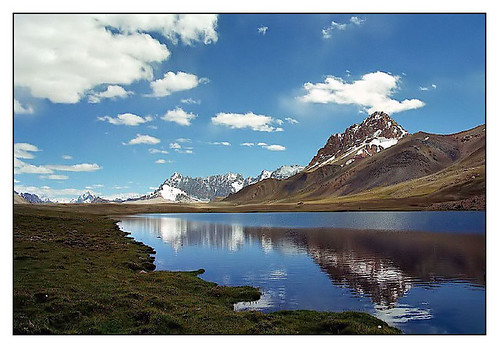
Historical Background
According to one of several popular histories of the community, the village of Shimshal was founded some four centuries ago by Mamu Singh, a Burusho from Baltit (Central Hunza), and a member of the Wazir's (prime-minister's) family. Mamu Singh was sent to Sarikol, Central Asia, as ambassador, but later fled Sarikol with his Wakhi wife Khodija, when relations with Hunza deteriorated. They were pursued into the Upper Hunza River Valley, as far as Avgarch Pasture on the slopes of Qarun Pir, where they made their home for several years before migrating into the lower reaches of the Shimshal Valley. There Mamu Singh built up his flocks of sheep and goats, and explored up the Shimshal Valley, eventually discovering a hole in the ground, whose mouth was covered with a great piece of slate. When he succeeded in removing the stone, water gushed from the hole and flowed along the remains of a channel that had been built by earlier travellers who had passed that way on their way over Pamir to Chinese Turkestan. Here in disrepair, but already constructed, was a channel from which Mamu Singh could build a village. At this time he was an elderly man, without children. However, after a miraculous visit from a holy man named Shams, Khodija gave birth to a son, by the name of Sher. Sher grew quickly to be big and strong, and an especially fine hunter. On one of his hunting trips he wandered up a side valley onto the Pamir, where he met a group of strangers, who had with them a number of horses and one small yak. Both Sher and the party of strangers claimed the Pamir as their own. Eventually they agreed to resolve the dispute with a polo game, using all Pamir as the playing field: if Sher drove the ball over Shimshal Pass toward Shuwert, he would win title to all territory from Shimshal to Raskam; if the Chinese succeeded in carrying the ball to Shuijerab, Sher must relinquish all lands from Pamir to the Hunza River. Riding the yak, against the strangers' horses, Sher succeeded in driving the ball over Shimshal Pass and beyond Shuwert. Having won the territory Sher began at once to explore it as far as Raskam. Half a year later, when his family had finally given him up for lost, Sher returned to Shimshal. He eventually married a Wakhi women from Sarikol, who bore him several sons, the descendants of whom founded the three main lineage groupings of Shimshal: Gazikator, Bakhtikator and Baqikator. Soon after, their forefathers established fealty with the ruler of Hunza, becoming the first Wakhi-speaking community in Hunza, the first permanent settlement in what is now Gojal (Wakhi speaking upper Hunza), and one of Hunza's first communities to be a mix of Wakhi and Burusho social and cultural organisation from its origin. Fifteen generations have passed since Sher's adventures. Late in the last century a missionary from Sarikol ventured into Hunza, and preached the Ismaili gospel to the ruler of Hunza, who accepted the faith and endeavoured to convert his subjects. Shimshalis have been devout Ismailis since then.
More recent historical events are also recounted in local stories, and are corroborated in the published accounts of foreign visitors. Some dozen parties of foreigners visited Shimsili community during the period from 1891 to 1975. Since the mid-eighties foreign and down country travellers have visited Shimshal with increasing frequency. Early exploration accounts stressed the community's isolation, its apparent autonomy from the kingdom of Hunza, its usefulness as a place from which to stage raids across Shimshal Pass on caravans travelling the Leh to Yarkand route, and its susceptibility to catastrophic glacier dam-burst floods. The most recent of these floods occurred in 1964, destroying many terraces and half the original clustered settlement. Since then Shimshalis have rebuilt on a dispersed pattern, and have redoubled their land settlement efforts, extending the area of terraced fields, improving (and re-improving) pasture areas, and developing terraces and plantations in some pastures and along the route into Shimshal.
Shimshali men are amongst the world’s best mountain climbers. Some of them have been to all 5 Peaks of Pakistan higher than 8,000 meter. Quite recently (In May 2006), a 15 years girl of Shimshal Village, alongwith her two brothers, climbed the Malongdati Sar, a peak in Shimshal, higher than 6,000 meter. She has the owner to be the first and the youngest Pakistani female mountain climber.
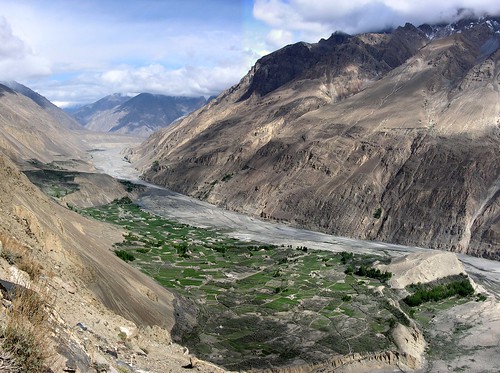
Wildlife
The Shimshal area is rich in fauna and many threatened wildlife species are found in this area. It is the only place where Tibetan Wild Ass (Equus bemionus kiang), and Blue Sheep (Pseudois nayaur) are found. Snow leopard (Uncia uncial) and Himalayan ibex (Felis lynx) are, Golden Marmots (Marmota caudate) are also found in Shimshal.
 Unknown
Unknown








0 komentar:
Post a Comment